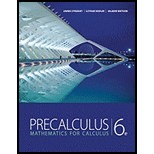
Concept explainers
To calculate: The division of the rational expression,
Answer to Problem 33E
The division of rational expression is
Explanation of Solution
Given information:
The expression is given as:
Formula used:
For the rational expression:
Fractions property for dividing rational expression:
Fractions property for multiplying rational expression:
Product formula:
Factoring trinomials: The factor of algebraic expression which contain three terms is of the from
Choose the values of
Calculation:
Consider the, algebraic expression
Use the fraction property for dividing rational expression
Use the fraction property for multiplying rational expression
Factor the first and second terms in numerator by Factoring trinomials rule,
Factor the first and second terms in denominator by Factoring trinomials rule,
Cancel the common factors from the numerator and denominator,
Thus, the division of rational expression is
Chapter 1 Solutions
EBK PRECALCULUS: MATHEMATICS FOR CALCUL
 Calculus: Early TranscendentalsCalculusISBN:9781285741550Author:James StewartPublisher:Cengage Learning
Calculus: Early TranscendentalsCalculusISBN:9781285741550Author:James StewartPublisher:Cengage Learning Thomas' Calculus (14th Edition)CalculusISBN:9780134438986Author:Joel R. Hass, Christopher E. Heil, Maurice D. WeirPublisher:PEARSON
Thomas' Calculus (14th Edition)CalculusISBN:9780134438986Author:Joel R. Hass, Christopher E. Heil, Maurice D. WeirPublisher:PEARSON Calculus: Early Transcendentals (3rd Edition)CalculusISBN:9780134763644Author:William L. Briggs, Lyle Cochran, Bernard Gillett, Eric SchulzPublisher:PEARSON
Calculus: Early Transcendentals (3rd Edition)CalculusISBN:9780134763644Author:William L. Briggs, Lyle Cochran, Bernard Gillett, Eric SchulzPublisher:PEARSON Calculus: Early TranscendentalsCalculusISBN:9781319050740Author:Jon Rogawski, Colin Adams, Robert FranzosaPublisher:W. H. Freeman
Calculus: Early TranscendentalsCalculusISBN:9781319050740Author:Jon Rogawski, Colin Adams, Robert FranzosaPublisher:W. H. Freeman
 Calculus: Early Transcendental FunctionsCalculusISBN:9781337552516Author:Ron Larson, Bruce H. EdwardsPublisher:Cengage Learning
Calculus: Early Transcendental FunctionsCalculusISBN:9781337552516Author:Ron Larson, Bruce H. EdwardsPublisher:Cengage Learning





